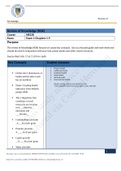Samenvatting
Knowledge Management - Summary 2019 - including notes of the lectures.
- Instelling
- Tilburg University (UVT)
This is a summary conducted on basis of the book Knowledge Management in Theory and Practice of Dalkir. It includes Chapter 1, 2, 3 and 5 of the "Knowledge" part. Including the notes made during the lectures. Updated: innovation part.
[Meer zien]














